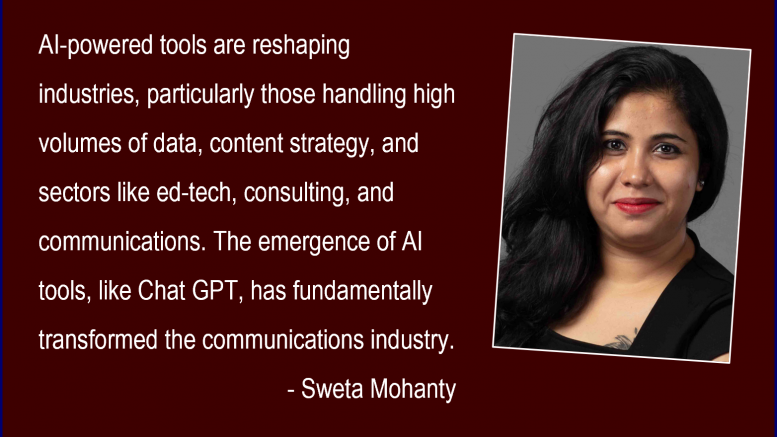As Microsoft CEO Satya Nadella puts it, technology is a double-edged sword: it can liberate the workforce and unleash creativity, but failure to adapt can result in displacement. The key is to evolve alongside technology, harnessing its capabilities to augment skills and create new opportunities.
From the 18th century to the present, our relentless pursuit of innovation showcases technology’s evolving role in our lives. Over the past three decades, the intricate interplay between technology, transformation, and the workforce has shaped a dynamic and enterprising landscape. However, the impact of technology on industries and the workforce can be traced back even further, to the advent of the Industrial Revolution in the late 18th century. Significant milestones such as the spinning jenny and water frame mechanised textile production, heralding the era of industrialisation. As time progressed, automation, AI, and machine learning emerged in the late 20th century, revolutionising tasks and introducing intelligent systems. For instance, the introduction of industrial robots in the 1960s transformed assembly line manufacturing, leaving a lasting imprint. Notably, these advancements extended beyond manufacturing, permeating into the services sectors as well.
Today, we find ourselves in an entirely new era of technological innovation. A prime example is the remarkable rise of advanced Open AI models that have taken the workforce, particularly in the services industries, by storm. These models, trained on vast amounts of data, have the ability to generate research-backed, human-like content, thereby enhancing communication and efficiency across various industries.
So, how is today any different from two centuries ago? The answer lies in agility and relevance…
In today’s digital landscape, workforce agility is essential for staying relevant amidst industry shifts. Global Inc. recognises the need for a swift transition to new operations, requiring significant investment in upskilling their workforce. According to Statista, global spending on AI training reached approximately $50 billion in 2020 and continues to increase year-on-year. For example, over the past six months, organisations worldwide have deeply invested in building AI competencies and capacities within their workforce, especially for tools like Chat GPT etc.
AI-powered tools are reshaping industries, particularly those handling high volumes of data, content strategy, and sectors like ed-tech, consulting, and communications. The emergence of AI tools, like Chat GPT, has fundamentally transformed the communications industry. Mastery of these tools is imperative for communications professionals, as they provide tremendous advantages in driving effective communication strategies.
But what does it mean for a professional in the communications industry?
- In today’s attention-deficient digital landscape, content creation and optimisation are critical for brands to captivate their audience. Marketers cite creating engaging content as their top challenge, yet active blogging boosts website visits by 55% and indexed pages by 434% (HubSpot). Chat GPT’s AI tools assist professionals by efficiently generating high-quality content, maximising audience reach, and impact.
- On the other hand, data-driven decision making is increasingly crucial in shaping effective communication strategies. McKinsey found that organisations embracing data-driven approaches achieve 5-6% higher productivity and profitability. Other research indicates that 97.2% of executives are investing in big data and AI initiatives, recognising the value of data-driven insights. The integration of AI tools is essential for communications professionals aiming to leverage data analysis, pattern recognition, and informed decision-making in their strategic endeavours.
- AI tools offer automation and efficiency, saving up to 20% of individual work time (McKinsey). Chatbots powered by AI can save businesses $8 billion annually by 2022 (Forrester). By adopting AI, professionals can streamline workflows, focus on strategic initiatives, and boost productivity.
- Content localisation through AI-powered tools empowers professionals to engage with diverse audiences, expand reach, and foster stronger connections.
- Real-time monitoring and sentiment analysis are crucial, as 89% of social media messages go unanswered. AI tools enable proactive, personalised communication across social media platforms, news outlets, and online channels.
Embracing these tools empowers communications professionals to unlock enhanced customer engagement, streamline content creation and optimisation, leverage data-driven insights, automate tasks, monitor real-time sentiments, and overcome language barriers.
While there are undeniable benefits, the integration of ChatGPT with the workforce also raises concerns. Automated tools can introduce complacency and lethargy, potentially undermining strategic thinking capabilities.
And then, there is the question of AI displacing communications professional. In my view, I feel that the prowess of AI can be leverage best with strategic and creative human intervention. However, I asked Chat GPT if it was here to displace a communications professional and here is what it had to say – “Hey, fellow comms pro! Don’t worry, AI won’t be snatching your job like a sneaky ninja. It’s more like your tech-savvy sidekick, here to supercharge your skills and help you conquer the world of communications! So, rock on and embrace the AI magic to take your game to the next level!”
The views and opinions published here belong to the author and do not necessarily reflect the views and opinions of the publisher.



Be the first to comment on "A Tryst With AI: A Communications Professionals’ Journey"